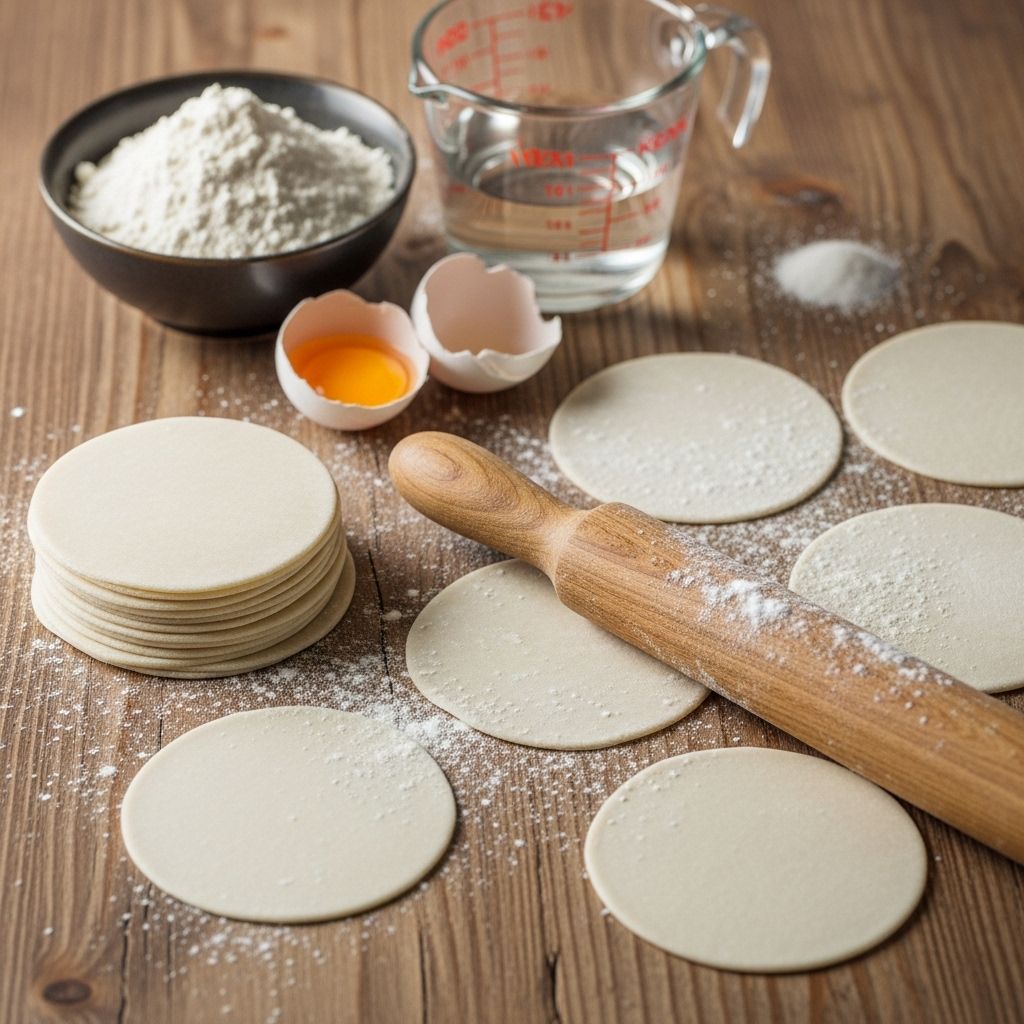Homemade Wonton Wrappers Recipe: 5 Easy Steps To Delicate Wraps
Master the art of making delicate, versatile wonton wrappers at home for delicious dumplings, appetizers, and more.

Image: HearthJunction Design Team
Homemade Wonton Wrappers: A Step-by-Step Guide
Wonton wrappers are the building blocks of many Asian favorites, from classic wontons to creative appetizers and even fusion dishes. While store-bought wrappers are convenient, making them from scratch yields a fresher, more delicate texture that elevates any dish. With just a few basic ingredients and straightforward methods, you can craft versatile wonton wrappers in your own kitchen. This comprehensive guide covers everything you need to know, including ingredients, equipment, step-by-step instructions, tips, uses, storage, troubleshooting, and answers to frequently asked questions.
What Are Wonton Wrappers?
Wonton wrappers are thin sheets of dough made from flour, water, egg, and salt. They provide the base for traditional wontons—a popular Chinese dumpling—and are also used for a wide variety of dishes, including ravioli, egg rolls, and even baked appetizers. Their pliable texture and mild flavor make them suitable for both savory and sweet creations.
Ingredients
- 1 egg: Provides structure and color to the dough.
- 3/4 cup water: Adds moisture to bring the dough together.
- 2 cups all-purpose flour: Forms the base of the dough and gives it body.
- 1/2 teaspoon salt: Enhances flavor.
Equipment Needed
- Mixing bowls (medium and large)
- Whisk or fork (for beating the egg)
- Measuring cups and spoons
- Rolling pin
- Sharp knife or pizza cutter
- Plastic wrap or damp towel (for covering dough)
- Clean, lightly floured surface for kneading and rolling
How to Make Wonton Wrappers: Step-by-Step Instructions
- Prepare the Dough
- In a medium bowl, beat the egg and mix with water.
- In a large bowl, combine the all-purpose flour and salt. Make a well in the center of the flour mixture.
- Pour the egg mixture into the well and gradually mix the flour into the liquid until a sticky dough forms.
- Knead the Dough
- Transfer the dough onto a lightly floured surface.
- Knead for 5-10 minutes, adding flour as necessary to prevent sticking, until the dough becomes smooth and elastic.
- Shape the kneaded dough into a ball, cover with a damp towel or plastic wrap, and let it rest for 30-60 minutes to relax the gluten. This makes rolling easier.
- Roll Out the Dough
- Divide the rested dough into two portions for easier handling.
- On a lightly floured surface, roll one piece of dough as thinly as possible, aiming for a thickness of about 1/16 inch (1.5 mm).
- Dust the top lightly with flour to prevent sticking.
- Cut into Squares
- Using a sharp knife or pizza cutter, trim the edges and cut the rolled dough into 3.5 to 4-inch squares, the classic size for wontons.
- Repeat with the remaining dough portion.
- Keep the cut wrappers covered with a damp towel to prevent them from drying out.
- Use or Store
- Wonton wrappers are ready for immediate use in your favorite recipes, or they can be stored for later (see storage tips below).
Tips for Perfect Wonton Wrappers
- Resting the dough is crucial for easy rolling and tender wrappers.
- Roll as thin as possible for delicate, light wontons—thicker wrappers may end up chewy.
- Use a ruler for uniform squares, especially if making larger batches.
- Dust wrappers lightly with flour and stack between sheets of parchment to prevent sticking.
- If the wrappers dry out, cover them with a slightly damp cloth, but avoid excess moisture, which can cause sticking.
- Don’t skip the salt—it enhances the overall flavor even in neutral-tasting wrappers.
Creative Uses for Wonton Wrappers
Wonton wrappers are incredibly versatile, making them a staple not just in Asian kitchens, but for creative cooks everywhere. Here are some popular uses:
- Traditional wontons: Filled with seasoned pork, shrimp, or vegetables, then boiled, steamed, or fried.
- Potstickers and dumplings: Similar dough, but wrappers may be thicker or round; homemade wrappers can be adapted for these.
- Crispy appetizers: Brush with oil and bake, or fry until golden for use as chips, cups, or shells.
- Mini ravioli or tortellini: Substitute wonton wrappers in Italian recipes for a fusion twist.
- Egg rolls: Cut larger rectangles or squares for homemade egg roll wrappers.
- Desserts: Fill with sweetened cream cheese, fruit, or chocolate, then bake or fry.
Serving Suggestions
- Wonton Soup: Fill wrappers with pork and shrimp, simmer in broth for a classic presentation.
- Crispy Wontons: Deep fry with savory or sweet fillings for party appetizers.
- Baked Wonton Cups: Press wrappers into muffin tins, bake, and fill with salads, dips, or taco filling.
- Asian-style Lasagna: Use wrappers as a substitute for traditional pasta sheets.
How to Store Wonton Wrappers
Homemade wonton wrappers are best used fresh, but they can also be stored for convenience:
- Refrigerator: Layer wrappers with parchment or wax paper. Keep in an airtight container for up to 2 days.
- Freezer: Freeze stacks of wrappers with parchment in between layers, sealed tightly in a freezer-safe bag. Use within 2 months for best quality. Thaw in the refrigerator before using.
Nutritional Information
| Serving Size | Calories | Fat (g) | Carbs (g) | Protein (g) | Sodium (mg) |
|---|---|---|---|---|---|
| 1 wrapper | 30 | 0.2 | 6 | 1 | 25 |
Nutrition values are approximate and may vary depending on exact ingredient amounts and thickness of wrappers.
Troubleshooting Common Issues
- Dough is too sticky: Knead in a little more flour until the dough is smooth.
- Dough is too dry or crumbly: Add water, 1 teaspoon at a time, and knead until pliable.
- Wrappers keep tearing: Dough may be too thin or not rested enough. Let it rest longer and roll just to the point of tenderness.
- Wrappers sticking together: Dust generously with flour and store with parchment between sheets.
Frequently Asked Questions (FAQs)
Q: Do I need a pasta machine to make wonton wrappers?
A: No, a rolling pin works perfectly well. Just roll the dough as thin as possible for best results.
Q: Can I use whole wheat flour instead of all-purpose flour?
A: Yes, but whole wheat flour will change the texture and flavor, making wrappers heartier and sometimes less pliable.
Q: Are wonton wrappers the same as egg roll wrappers?
A: They have similar ingredients, but egg roll wrappers are typically larger and a bit thicker. You can use this dough recipe for both by adjusting the size.
Q: Can I freeze homemade wonton wrappers?
A: Yes. Freeze in layers separated by parchment or wax paper inside a bag or airtight container. Thaw overnight in the refrigerator before using.
Q: How thin should I roll the wrappers?
A: Aim for about 1/16 inch (1.5 mm)—thin, but not transparent. Uniform thickness ensures even cooking.
Expert Tips for Success
- Work in small batches to prevent wrappers from drying out.
- Use a bench scraper or ruler for neat, even squares.
- Double the recipe for larger batches; homemade wrappers freeze well.
- If making dumplings or wontons, moisten the edges with water before sealing for a tight closure.
Conclusion
Making wonton wrappers from scratch is a satisfying and surprisingly simple process. With only a handful of accessible ingredients and basic kitchen tools, you can craft delicate, fresh wrappers for all your favorite dumplings and beyond. As you gain confidence, experiment with different shapes, fillings, and even flavors—the possibilities are endless. Whether you use them for classic wontons, creative appetizers, or sweet treats, homemade wonton wrappers bring delicious results to your table.
References
- https://www.allrecipes.com/recipe/20881/wonton-wrappers/
- https://www.allrecipes.com/recipe/20883/won-ton-wrapper-appetizers/
- https://www.allrecipes.com/recipe/217873/moms-wonton/
- https://www.allrecipes.com/recipe/236617/baked-cream-cheese-wontons/
- https://www.allrecipes.com/recipe/185519/homemade-wonton-soup/
Read full bio of Shinta












